Materials & Construction Systems in Costa Rica: Best Practices for Tropical Conditions
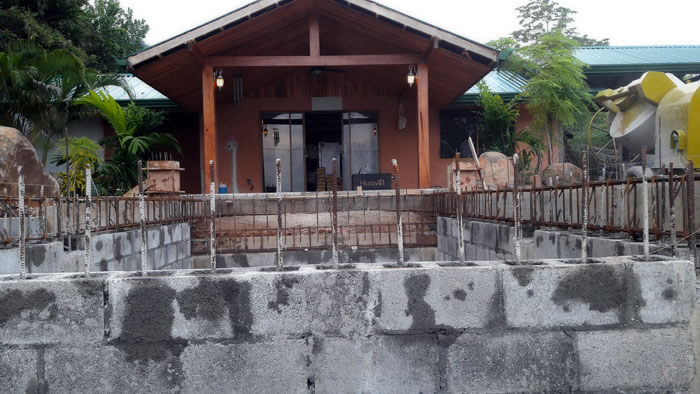
Introduction Costa Rica’s climate, geography, and building traditions pose both opportunities and challenges for architects, builders, and homeowners. High humidity, heavy rainfall, salt air (near coastlines), seismic risk, and the desire for indoor comfort all influence the smart selection of materials and systems. In this post we explore common materials and systems used in Costa Rica, and offer recommendations for durable, climate-sensitive construction. 1. Key Environmental Factors to Consider Before choosing materials or systems, these local conditions should guide design decisions: Humidity & Rain: Many regions receive heavy rainfall, and constant humidity can promote mold, rot, or corrosion. Solar heat & thermal comfort: Reducing heat gain and facilitating natural ventilation is critical. Salt air (coastal zones): Accelerates corrosion of metals and degradation of certain finishes. Seismic risk: Costa Rica lies in a tectonically active zone, so structural resilience is essential. Material availability and cost: Importing specialized materials raises cost; local supply and vernacular knowledge matter. Maintenance demands: Because of the climate, materials needing low maintenance are preferred in many contexts. With these in mind, let’s review common materials and systems and their pros/cons in Costa Rica. 2. Common Materials & Systems (with Pros & Cons) 2.1 Reinforced Concrete & Concrete Block Pros: Strong, durable, and well understood by local builders. Good mass helps dampen temperature swings (thermal inertia). Resistant to insects, rot, and many forms of wear. Amenable to seismic reinforcement (with rebar, shear walls). Cons / Considerations: Concrete production has a high carbon footprint (consider greener mixes). Without proper detailing, concrete walls can trap moisture — need drainage, waterproofing, and ventilation. Cracking or shrinkage can be issues if curing is not done carefully. Finishes (stucco, paint) must be resistant to moisture, UV, and biological growth. Use cases & tips: Use reinforced concrete frames and infill with concrete block (CMU) for walls. Always include proper flashing, waterproof membranes, and drainage paths. Provide movement joints to mitigate cracking. Use quality waterproof paints or mineral plasters. 2.2 Steel Frame / Metal Structure Pros: Quick to erect; lighter than full concrete structures. Flexibility in architectural forms and spans. Often easier to integrate services (plumbing, electrical) in hollow spaces. Cons / Considerations: Prone to corrosion, especially near the coast (must use corrosion-resistant coatings or stainless elements). Must carefully avoid thermal bridging (metal can conduct heat). Hollow walls require good detailing to avoid condensation, mold, or pest infiltration. Use cases & tips: Use galvanized steel or protected steel beams and columns. Cover with moisture resistive sheathing (cement board, fiber cement) and ventilated cladding. Provide thermal breaks (insulation between interior finishes and steel shell). In coastal areas, periodic maintenance (coatings) is critical. 2.3 Timber & Engineered Wood Pros: Aesthetic warmth and natural character. Lightweight, which is helpful for certain soils or seismic design if detailed properly. Renewable (if sourced responsibly). Cons / Considerations: Susceptible to insect attack, rot, warping, and fungal growth unless treated. High maintenance demands (repainting, sealing) under tropical conditions. Structural strength is lower compared to concrete/steel for large spans, unless engineered. Use cases & tips: Use for non-structural elements (ceilings, decks, exterior accents) rather than primary structural walls in humid zones. Use tropical hardwoods or treated wood resistant to moisture / pests. Ensure good overhangs, drainage, and ventilation around wood to prolong life. Inspect and re-seal finishes periodically. 2.4 Bamboo & Sustainable / Alternative Materials Pros: Rapidly renewable and high strength-to-weight ratio (for certain bamboo species). Lower embodied carbon compared to concrete or steel. Ideal in ecological or “green” design settings. Cons / Considerations: Less common in mainstream Costa Rican construction; may require specialized skill. Ends and joints must be well detailed against moisture ingress. Protective treatments are essential to resist rot, insects, and fungal decay. Use cases & tips: Use as decorative structural elements, pergolas, or lighter roof structures. Combine with more durable materials for base and foundation. Use treated bamboo and ensure protective roof overhangs to shield from rain. Consider hybrid systems (bamboo + steel/concrete) to get best of both. 2.5 Composite / Panel Systems (e.g. insulated panels, concrete + foam cores) Pros: Good thermal insulation performance when properly executed. Speed of assembly (modular or panelized installation). Possible weight reduction. Cons / Considerations: Quality control is critical (any flaw in the envelope can lead to moisture problems). Some materials (like polystyrene cores) may degrade in tropical UV or under humidity stress. Repairing damage may be more complex, requiring specialist expertise. Use cases & tips: Use in mid-rise or higher-end housing where the components are properly rated for tropical use. Ensure all joints are sealed, membranes are continuous, and ventilation is planned. Avoid materials that trap moisture; always allow drying paths. Prioritize local suppliers and tested systems to reduce risk. 3. Recommendations Specific to Costa Rica Here are some best-practice tips adapted to Costa Rican climate zones, costs, and cultural preferences: Prioritize moisture control & ventilation Always design with overhangs, eaves, and porches to shield walls from rain. Use breathable membranes, drainage planes, and ventilated cavities. Encourage cross ventilation — align windows and openings to prevailing breezes. Use durable exterior finishes & protective coatings Use high-quality paints, mineral plasters, or waterproof coatings rated for tropical UV. Avoid finishes that degrade quickly under constant humidity or salt exposure. Select materials based on zone Inland highland areas may tolerate more traditional or heavier materials. Coastal zones require extra attention to corrosion, salt penetration, and wind loads. Blend local knowledge and imported innovation Use local materials and construction techniques when possible (lower cost, better familiarity). But don’t shy from imported systems if they offer energy/maintenance advantages — just ensure they are adapted for tropical performance. Design for phased maintenance Assume periodic maintenance (coating steel, resealing wood) is inevitable in this climate. Make those interventions easy (access, replaceable elements). Employ good structural design Work with structural engineers to ensure seismic and wind resilience. Use reinforced cores, shear walls, or braced frames in concrete or steel systems. Control costs wisely Invest more upfront in a robust envelope rather than cheap finishes that will degrade. Bulk
Decks for Exterior and Interior.
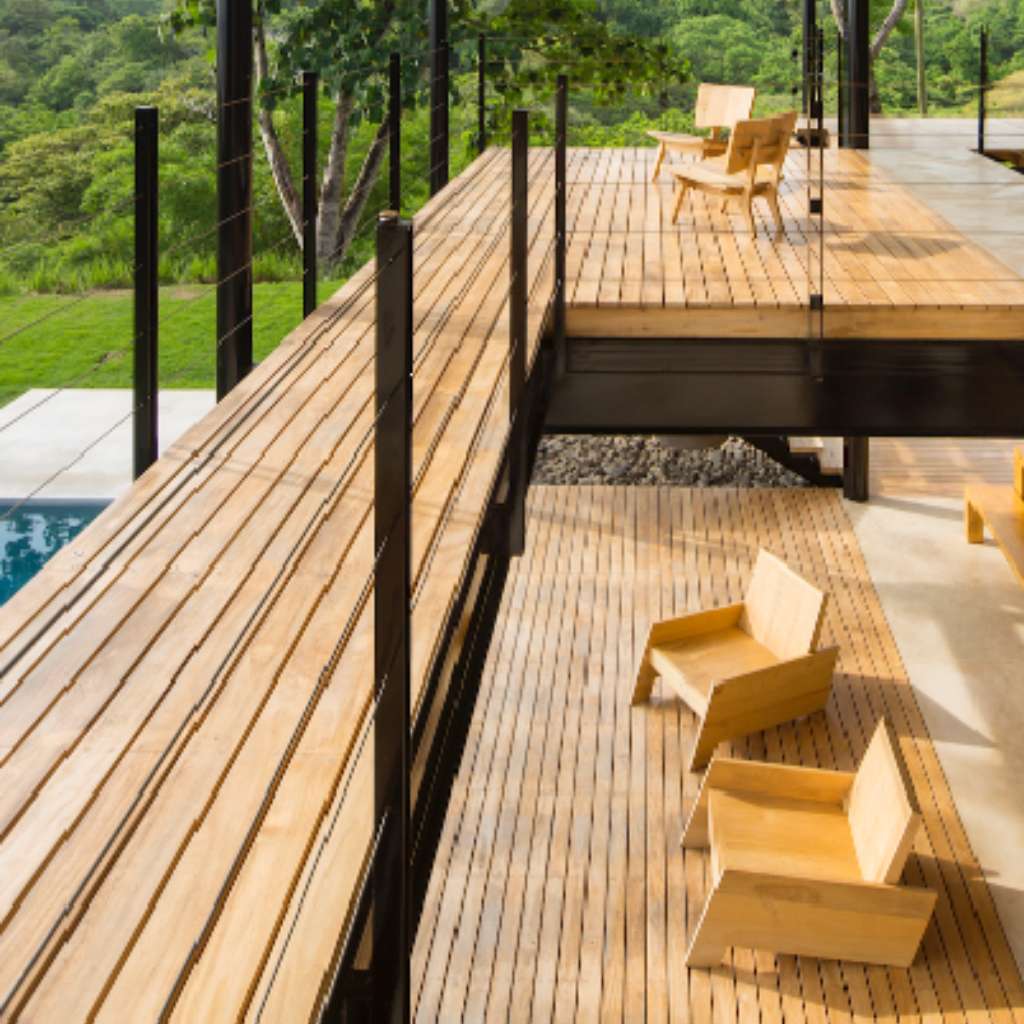
The use of decks in residential and commercial projects has evolved in recent years, not only as an aesthetic element but also as a practical solution for social areas, hallways, terraces, and wet zones. The choice of the right material depends on factors such as climate exposure, maintenance, durability, and budget. Below are the main types of decks available on the market and their technical characteristics. Natural wood has traditionally been the most widely used material. It is warm, versatile, and offers a unique finish. Thickness, width, and length can be customized, as well as edges or trims with pieces up to 12” (30 cm). In Costa Rica, the most common species are teak, melina, and almendro, sourced from certified plantations. It requires prior pest treatment, for which it is recommended to submerge the pieces in the chosen pesticide before installation. Afterwards, oil or varnish resistant to humidity and UV rays is applied. Maintenance should be performed every six months. It can be installed indoors or outdoors, fastened with top screws or hidden clips. Engineered bamboo is manufactured from bamboo fibers compressed at high density with resins and subjected to thermal treatments. It comes in pieces of 185 cm long, 14 cm wide, and 20 mm thick. It is a renewable material, highly durable, waterproof, mold- and fungus-resistant, and UV-protected. The most common colors are light walnut, dark walnut, and wenge. It is recommended for indoor and exposed outdoor areas, high-traffic social spaces, and coastal zones. It comes with up to a 25-year warranty and requires semi-annual maintenance with resealing to prevent discoloration and humidity-related degradation. The ceramic deck, commercially known as Exadeck, is made of extruded porcelain stoneware with a wood-like appearance. It is manufactured in pieces of 122 cm long, 14 cm wide, and 26 mm thick. It is thermostable, non-slip, and highly resistant to sun, rain, breakage, and abrasion, making it ideal for outdoor installations and high-traffic areas. It is available in seven colors: maple, oak, teak, antico, mahogany, natural, and grey. Recommended uses include indoor and exposed outdoor areas, social spaces, and coastal zones. It comes with a warranty of up to 30 years and requires minimal maintenance. PVC decks are made primarily from polyvinyl chloride and additives, imitating the texture of natural wood but with greater durability and resistance to weather, water, pests, and sun. Its look and feel are less natural, and it does not allow for size customization, with edges or trims up to 8” (20 cm). It is available in shades of gray, brown, and sand. This material is resistant to water, UV rays, and stains, but may present premature discoloration and unexpected contraction. Its warranty ranges between 10 and 20 years depending on the manufacturer. It is recommended for pools, jacuzzis, and coastal areas, though exposure to direct sunlight should be considered. It is not very suitable for interiors due to its artificial appearance. WPC is a composite of wood fibers and recycled polymers. Its sizes are not customizable and, like PVC, it allows trims up to 8” (20 cm). It is resistant to humidity, insects, and UV rays, although its appearance and texture are also less natural. The most common colors are gray, brown, walnut, and teak. It requires low maintenance, but it can heat up under the sun and show premature discoloration or contraction. Its warranty ranges from 10 to 20 years. It is recommended for shaded outdoor areas, high-traffic social spaces, and coastal zones, but less so for interiors where wood authenticity is desired. In conclusion, there is no “one-size-fits-all” material for decks. The selection depends on location, intended use, and the desired aesthetic. While wood provides warmth and tradition, PVC and WPC ensure durability in outdoor conditions; bamboo contributes sustainability, and ceramic offers maximum resistance. Choosing the right option means balancing technical performance, design, and long-term maintenance.
Smart Materials & Efficient Systems: Modern Strategies for Superior Construction
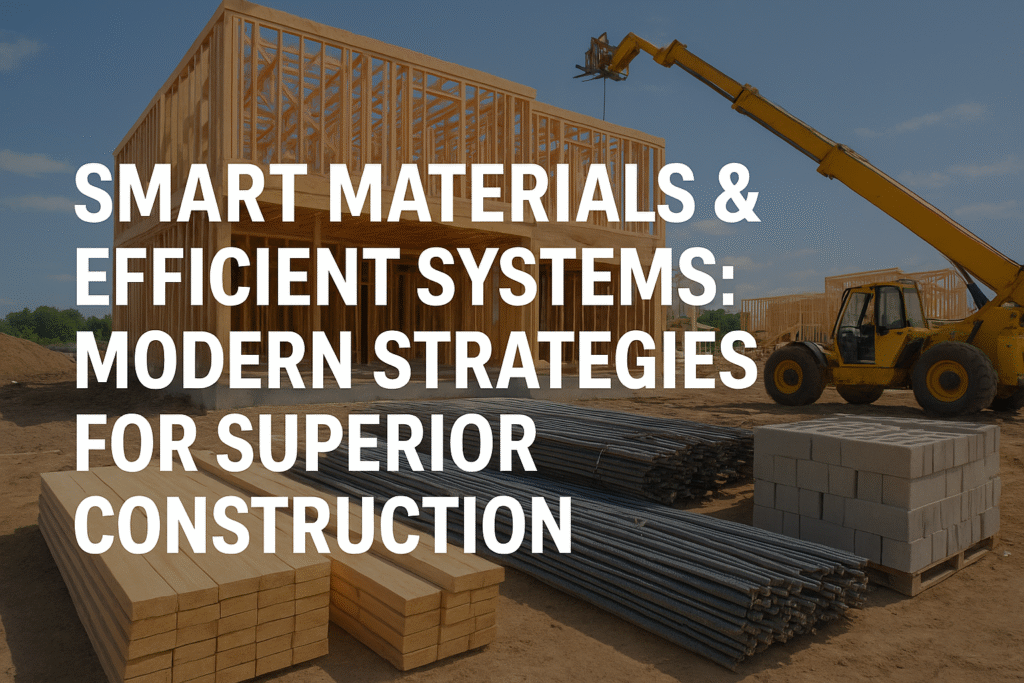
Introduction In the world of custom home building, smart selection and management of materials and construction systems are key to delivering homes that are not only beautiful but also durable, efficient, and sustainable. This blog post dives into the best practices and the latest innovations shaping modern construction at AA Building Co. 1. The Value of High-Quality Material Selection Choosing materials wisely—whether it’s sustainably sourced timber, engineered wood, or advanced composites—lays the foundation for a well-performing home. Materials with high thermal efficiency, low maintenance, and strong structural integrity offer long-term benefits and enhance client satisfaction. 2. Embracing Prefabrication & Engineered Wood Prefabrication reduces waste, accelerates build times, and improves on-site quality control. Off-site fabrication of concrete panels or steel components ensures precision and efficiency Wikipedia.Mass timber—like CLT (Cross-Laminated Timber) and glulam—offers structural strength comparable to steel or concrete, with added advantages in fire resistance and faster construction when manufactured off-site Wikipedia. 3. Sustainability Through Bio-based & Recycled Materials Modern construction increasingly relies on eco-friendly materials to reduce environmental impact. Fast-growing bio-based options like hemp, straw, bamboo, and rice-husk composites lower embodied carbon and offer exceptional thermal and acoustic properties Wikipedia.Innovative materials—from algae bricks and oyster-shell panels to mycelium-based alternatives—are being explored globally, offering future-forward, sustainable options despite challenges like certification and cost The GuardianWallpaper*. 4. Green Building and Energy Efficiency Green building focuses on reducing environmental impact during both construction and lifecycle of a building. Energy-efficient materials—insulation like cork, wool, cellulose, or recycled substitutes—help drive performance and durability, complementing overall sustainability goals Wikipedia. 5. Adaptive & Circular Approaches 6. Bringing It All Together: AA Building Co’s Approach At AA Building Co, excellence in construction starts with materials and systems that align with your vision and values: Conclusion Today’s construction is about more than structures—it’s about smart, sustainable, and resource-respecting building. By leveraging advanced materials, efficient systems, and circular design, AA Building Co creates homes that are efficient, enduring, and environmentally thoughtful.
Exploring the Future of Construction Materials and Systems: Sustainable Solutions for a Greener Tomorrow
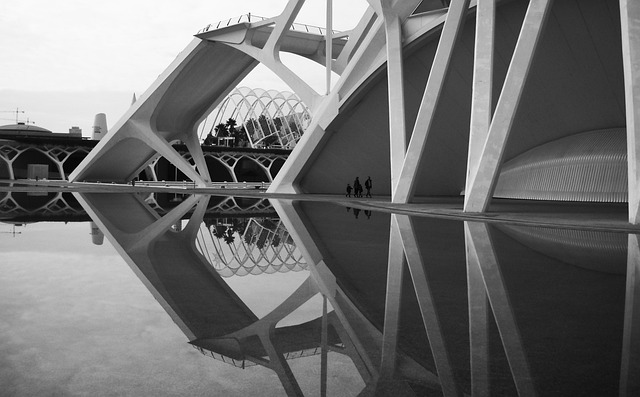
In today’s ever-evolving construction industry, innovation is the key to building structures that are not only durable and cost-effective but also environmentally responsible. The importance of choosing the right materials and construction systems cannot be overstated, as these decisions directly impact the efficiency, sustainability, and longevity of a project. At AA Building Co., we recognize the significance of staying ahead of the curve when it comes to new material technologies and construction systems, ensuring that we deliver the best possible results for our clients and the environment. Sustainable Materials: Building the Future As the world faces the pressing challenges of climate change, the construction industry is making strides toward adopting sustainable building materials. These materials aim to reduce environmental impact while maintaining high-performance standards. Some of the most promising materials include: Advanced Construction Systems: Efficiency Meets Innovation Alongside sustainable materials, advancements in construction systems are transforming the way buildings are designed and constructed. These systems not only improve efficiency but also ensure that projects are completed on time and within budget. Some of the key systems gaining traction in the industry include: Conclusion At AA Building Co., we are committed to staying at the forefront of material and construction system advancements. As the demand for sustainable, energy-efficient buildings continues to grow, we are dedicated to incorporating the latest innovations to ensure that every project we undertake is both environmentally responsible and of the highest quality. By embracing these cutting-edge materials and systems, we are not just building structures – we are shaping the future of the construction industry. Whether it’s using eco-friendly materials, adopting modern construction methods, or integrating smart technologies, the goal is clear: to build a more sustainable, efficient, and resilient world for future generations.
Materials and Construction
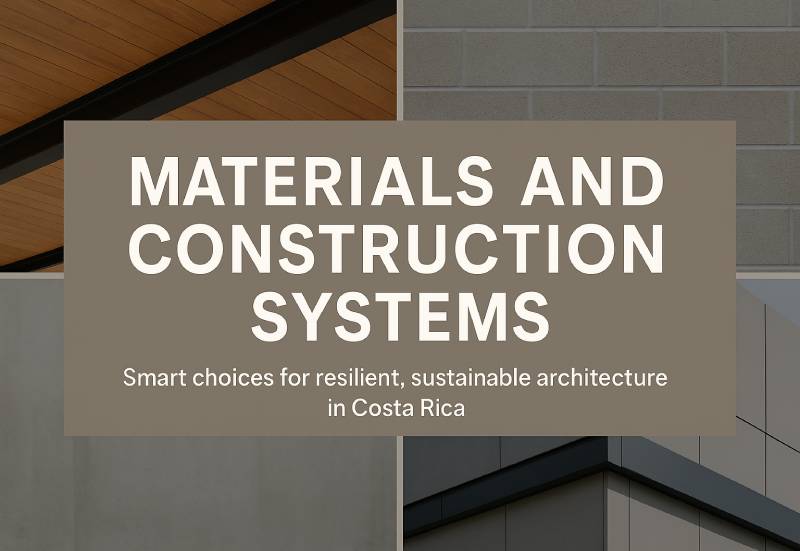
Smart choices for resilient, sustainable architecture in Costa Rica Every architectural project is a response to its context—and materials are the language that give that response form. At AA Building Co., we understand that choosing the right construction systems and materials is not just about aesthetics or cost. It’s about durability, efficiency, climate adaptability, and long-term performance. Costa Rica presents a unique set of opportunities and challenges: tropical climate, seismic zones, diverse topography, and a growing demand for sustainable construction. Through years of experience, we’ve developed an approach that balances local materials, advanced construction technologies, and context-driven strategies. 1. Tropical climate requires resilient and breathable materials In regions with high humidity and rainfall, the wrong material choice can lead to rapid deterioration. We favor breathable, low-maintenance materials like fiber-cement panels, treated native woods, and exposed concrete with water-repellent sealers. We also design with ventilated façades and roof systems that encourage airflow and minimize thermal gain. Key takeaway: Materials must respond to climate—not just design trends. 2. Hybrid construction systems enhance performance and speed We often integrate hybrid systems—such as combining steel frames with concrete block infill or using light-gauge metal framing with panelized enclosures. These systems offer faster construction times, reduced waste, and better seismic performance—essential in a country like Costa Rica. Key takeaway: The right system reduces construction time while improving resilience. 3. Local materials connect architecture with place We actively seek ways to incorporate materials of local origin, not only to reduce environmental impact, but to ground the architecture in its geographic and cultural context. Wood species like teak, melina, and cedar, locally sourced stone, and artisanal finishes give each project a sense of authenticity and permanence. Key takeaway: Material selection is a cultural act as much as a technical one. 4. Efficiency begins with construction systems Choosing the right construction system from the beginning can define the success of a project. Prefabricated components, modular design, and BIM-based coordination reduce on-site conflict and increase budget predictability. We prioritize buildability, ensuring that what’s designed can be executed cleanly and precisely. Key takeaway: Buildability and design excellence go hand in hand. 5. Sustainable materials are the future—now Clients increasingly demand buildings that reflect ecological responsibility. We specify low-VOC finishes, recycled aggregates, FSC-certified wood, and solar-ready roofing systems as part of our baseline. Our role as architects is to push for solutions that benefit both the environment and the user experience. Key takeaway: Sustainability isn’t a feature—it’s a foundation. Final Thoughts Architecture is more than form—it is matter. The materials we choose and the systems we implement define how spaces will age, perform, and connect with their users. At AA Building Co., we treat these decisions as opportunities to elevate every project. Whether it’s a beachfront villa or a high-performance office space, we bring together technical rigor and design sensitivity to deliver architecture that’s as intelligent as it is beautiful. Explore our work here or contact us to learn more about how materials and systems shape exceptional architecture in Costa Rica. SEO Keywords: architecture in Costa Rica, tropical construction systems, sustainable building materials, hybrid construction Costa Rica, local architecture materials, AA Building Co., modern architecture systems, passive design Costa Rica, smart construction